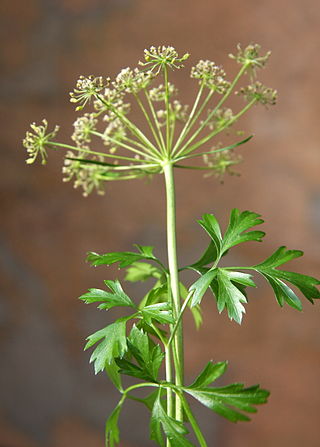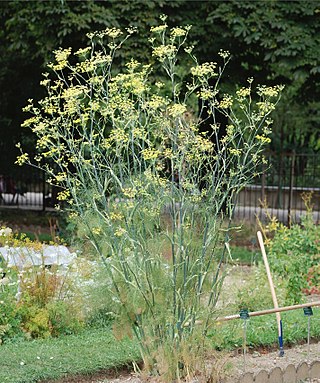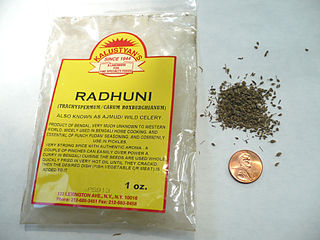
Apiaceae or Umbelliferae is a family of mostly aromatic flowering plants named after the type genus Apium and commonly known as the celery, carrot or parsley family, or simply as umbellifers. It is the 16th-largest family of flowering plants, with more than 3,800 species in about 446 genera, including such well-known and economically important plants as ajwain, angelica, anise, asafoetida, caraway, carrot, celery, chervil, coriander, cumin, dill, fennel, lovage, cow parsley, parsley, parsnip and sea holly, as well as silphium, a plant whose identity is unclear and which may be extinct.

Dill is an annual herb in the celery family Apiaceae. It is native to North Africa, Iran, and the Arabian Peninsula; it is grown widely in Eurasia, where its leaves and seeds are used as a herb or spice for flavouring food.

Parsley, or garden parsley is a species of flowering plant in the family Apiaceae that is native to Greece, Morocco and the former Yugoslavia. It has been introduced and naturalized in Europe and elsewhere in the world with suitable climates, and is widely cultivated as a herb, and a vegetable.

Thyme is the herb of some members of the genus Thymus of aromatic perennial evergreen herbs in the mint family Lamiaceae. Thymes are relatives of the oregano genus Origanum, with both plants being mostly indigenous to the Mediterranean region. Thymes have culinary, medicinal, and ornamental uses, and the species most commonly cultivated and used for culinary purposes is Thymus vulgaris.

Anise, also called aniseed or rarely anix is a flowering plant in the family Apiaceae native to the eastern Mediterranean region and Southwest Asia.

Fennel is a flowering plant species in the carrot family. It is a hardy, perennial herb with yellow flowers and feathery leaves. It is indigenous to the shores of the Mediterranean but has become widely naturalized in many parts of the world, especially on dry soils near the sea-coast and on riverbanks.

Coriander, also known as cilantro, is an annual herb in the family Apiaceae. All parts of the plant are edible, but the fresh leaves and the dried seeds are the parts most traditionally used in cooking.

Ajwain or ajowan —also known as ajowan caraway, omam , thymol seeds, bishop's weed, or carom—is an annual herb in the family Apiaceae. Both the leaves and the seed‑like fruit of the plant are consumed by humans. The name "bishop's weed" also is a common name for other plants. The "seed" is often confused with lovage seed.
Latvian cuisine typically consists of agricultural products, with meat featuring in most main meal dishes. Fish is commonly consumed due to Latvia's location on the eastern shore of the Baltic Sea.

Carvone is a member of a family of chemicals called terpenoids. Carvone is found naturally in many essential oils, but is most abundant in the oils from seeds of caraway, spearmint, and dill.

Myrrhis odorata, with common names cicely, sweet cicely, myrrh, garden myrrh, and sweet chervil, is a herbaceous perennial plant belonging to the celery family Apiaceae. It is the only species in the genus Myrrhis.

Trachyspermum roxburghianum is a flowering plant in the family Apiaceae. It is grown extensively in South Asia, Southeast Asia, and Indonesia. Its aromatic dried fruits, like those of its close relative ajwain, are often used in Bengali cuisine but are rarely used in the rest of India. The fresh leaves are used as an herb in Thailand and it is used medicinally in Myanmar and Sri Lanka.

Nigella sativa is an annual flowering plant in the family Ranunculaceae, native to eastern Europe and western Asia, but naturalized over a much wider area, including parts of Europe, northern Africa and east to Myanmar. It is used as a spice in many cuisines.

Tunisian cuisine, the cuisine of Tunisia, consists of the cooking traditions, ingredients, recipes and techniques developed in Tunisia since antiquity. It is mainly a blend of Mediterranean and native Punics-Berber cuisine. Historically, Tunisian cuisine witnessed influence and exchanges with many cultures and nations like Italians, Andalusians, French and Arabs.
The following outline is provided as an overview of and topical guide to herbs and spices:

Cumin is a flowering plant in the family Apiaceae, native to the Irano-Turanian Region. Its seeds – each one contained within a fruit, which is dried – are used in the cuisines of many cultures in both whole and ground form. Although cumin is used in traditional medicine, there is no high-quality evidence that it is safe or effective as a therapeutic agent.

The history of spices reach back thousands of years, dating back to the 8th century B.C. Spices are widely known to be developed and discovered in Asian civilizations. Spices have been used in a variety of antique developments for their unique qualities. There were a variety of spices that were used for common purposes across the ancient world. Different spices hold a value that can create a variety of products designed to enhance or suppress certain taste and/or sensations. Spices were also associated with certain rituals to perpetuate a superstition or fulfill a religious obligation, among other things.
















